BUS703 : Managing Research Assessment
VerifiedAdded on 2021/06/17
|14
|4639
|68
AI Summary
Contribute Materials
Your contribution can guide someone’s learning journey. Share your
documents today.
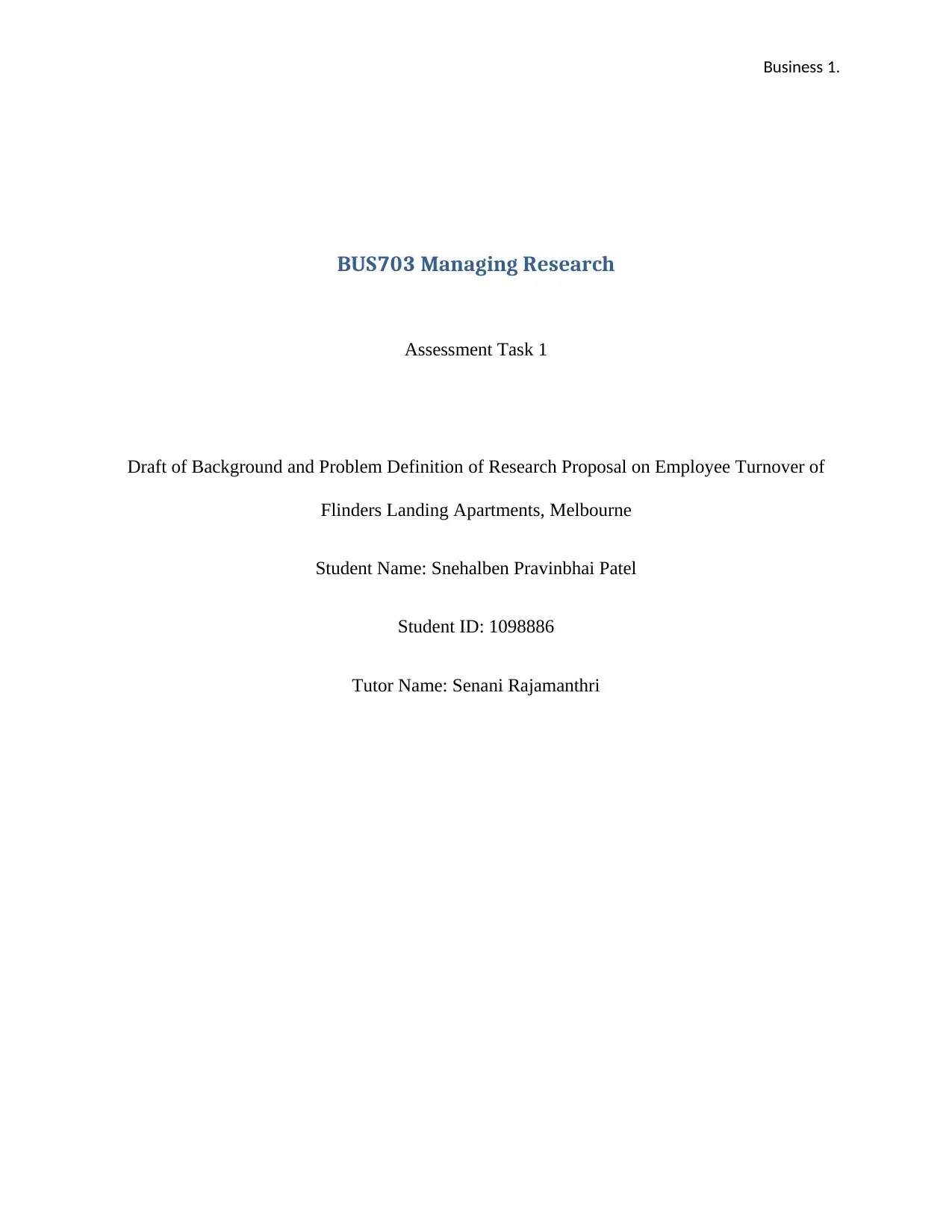
Business 1.
BUS703 Managing Research
Assessment Task 1
Draft of Background and Problem Definition of Research Proposal on Employee Turnover of
Flinders Landing Apartments, Melbourne
Student Name: Snehalben Pravinbhai Patel
Student ID: 1098886
Tutor Name: Senani Rajamanthri
BUS703 Managing Research
Assessment Task 1
Draft of Background and Problem Definition of Research Proposal on Employee Turnover of
Flinders Landing Apartments, Melbourne
Student Name: Snehalben Pravinbhai Patel
Student ID: 1098886
Tutor Name: Senani Rajamanthri
Secure Best Marks with AI Grader
Need help grading? Try our AI Grader for instant feedback on your assignments.
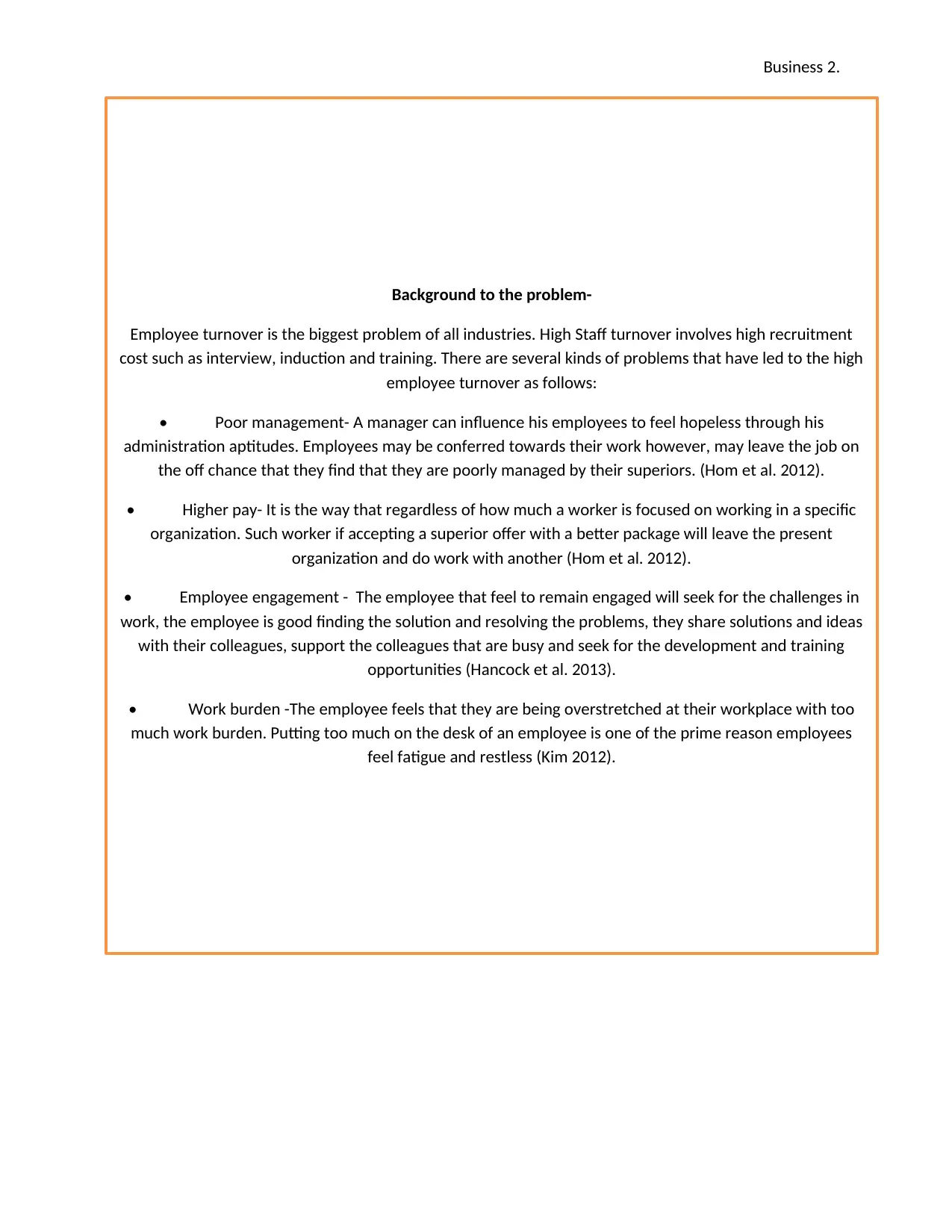
Business 2.
Background to the problem-
Employee turnover is the biggest problem of all industries. High Staff turnover involves high
recruitment cost such as interview, induction and training. There are several kinds of problems
that have led to the high employee turnover as follows:
• Poor management- A manager can influence his employees to feel hopeless through his
administration aptitudes. Employees may be conferred towards their work however, may leave
the job on the off chance that they find that they are poorly managed by their superiors. (Hom et
al. 2012).
• Higher pay- It is the way that regardless of how much a worker is focused on working in
a specific organization. Such worker if accepting a superior offer with a better package will leave
the present organization and do work with another (Hom et al. 2012).
• Employee engagement - The employee that feel to remain engaged will seek for the
challenges in work, the employee is good finding the solution and resolving the problems, they
share solutions and ideas with their colleagues, support the colleagues that are busy and seek for
the development and training opportunities (Hancock et al. 2013).
• Work burden -The employee feels that they are being overstretched at their workplace
with too much work burden. Putting too much on the desk of an employee is one of the prime
reason employee feel fatigue and restless (Kim 2012).
Background to the problem-
Employee turnover is the biggest problem of all industries. High Staff turnover involves high recruitment
cost such as interview, induction and training. There are several kinds of problems that have led to the high
employee turnover as follows:
• Poor management- A manager can influence his employees to feel hopeless through his
administration aptitudes. Employees may be conferred towards their work however, may leave the job on
the off chance that they find that they are poorly managed by their superiors. (Hom et al. 2012).
• Higher pay- It is the way that regardless of how much a worker is focused on working in a specific
organization. Such worker if accepting a superior offer with a better package will leave the present
organization and do work with another (Hom et al. 2012).
• Employee engagement - The employee that feel to remain engaged will seek for the challenges in
work, the employee is good finding the solution and resolving the problems, they share solutions and ideas
with their colleagues, support the colleagues that are busy and seek for the development and training
opportunities (Hancock et al. 2013).
• Work burden -The employee feels that they are being overstretched at their workplace with too
much work burden. Putting too much on the desk of an employee is one of the prime reason employees
feel fatigue and restless (Kim 2012).
Background to the problem-
Employee turnover is the biggest problem of all industries. High Staff turnover involves high
recruitment cost such as interview, induction and training. There are several kinds of problems
that have led to the high employee turnover as follows:
• Poor management- A manager can influence his employees to feel hopeless through his
administration aptitudes. Employees may be conferred towards their work however, may leave
the job on the off chance that they find that they are poorly managed by their superiors. (Hom et
al. 2012).
• Higher pay- It is the way that regardless of how much a worker is focused on working in
a specific organization. Such worker if accepting a superior offer with a better package will leave
the present organization and do work with another (Hom et al. 2012).
• Employee engagement - The employee that feel to remain engaged will seek for the
challenges in work, the employee is good finding the solution and resolving the problems, they
share solutions and ideas with their colleagues, support the colleagues that are busy and seek for
the development and training opportunities (Hancock et al. 2013).
• Work burden -The employee feels that they are being overstretched at their workplace
with too much work burden. Putting too much on the desk of an employee is one of the prime
reason employee feel fatigue and restless (Kim 2012).
Background to the problem-
Employee turnover is the biggest problem of all industries. High Staff turnover involves high recruitment
cost such as interview, induction and training. There are several kinds of problems that have led to the high
employee turnover as follows:
• Poor management- A manager can influence his employees to feel hopeless through his
administration aptitudes. Employees may be conferred towards their work however, may leave the job on
the off chance that they find that they are poorly managed by their superiors. (Hom et al. 2012).
• Higher pay- It is the way that regardless of how much a worker is focused on working in a specific
organization. Such worker if accepting a superior offer with a better package will leave the present
organization and do work with another (Hom et al. 2012).
• Employee engagement - The employee that feel to remain engaged will seek for the challenges in
work, the employee is good finding the solution and resolving the problems, they share solutions and ideas
with their colleagues, support the colleagues that are busy and seek for the development and training
opportunities (Hancock et al. 2013).
• Work burden -The employee feels that they are being overstretched at their workplace with too
much work burden. Putting too much on the desk of an employee is one of the prime reason employees
feel fatigue and restless (Kim 2012).

Business 3.
Management decision
The management of the company is faced with a decision to make in relation to controlling the high
turnover rates in the company. The management therefore is required to make a decision on
developing effective employee motivation strategies that will help them reduce high turnover rates.
Such strategies will include the compensation strategies, career development strategies as well as the
employee social welfare benefits strategies.
This research proposal will help the management of the company to understand the main factors
contributing to increased turnover rates in the company and their impact on company or
organizational performance. The research proposal will provide possible strategies by which the
management can adopt in helping them solve the problems the company is facing due to increased
turnover rates.
Research question
• How the employee turnover affects an organization and the overall functioning and the
management of the organization?
• What are the different types of management styles undertaken for the reduction of the high
employee turnover?
• What are the different types of the cost incurred by the companies and the organization when
employee turnover rate increases?
• How the organization manages to save the cost of the employee turnover and the several
types of losses incurred due to the employee turnover?
• How long the human resource managers take to respond to filling the gap created by the
leaving employees?
Management decision
The management of the company is faced with a decision to make in relation to controlling the high
turnover rates in the company. The management therefore is required to make a decision on
developing effective employee motivation strategies that will help them reduce high turnover rates.
Such strategies will include the compensation strategies, career development strategies as well as the
employee social welfare benefits strategies.
This research proposal will help the management of the company to understand the main factors
contributing to increased turnover rates in the company and their impact on company or
organizational performance. The research proposal will provide possible strategies by which the
management can adopt in helping them solve the problems the company is facing due to increased
turnover rates.
Research question
• How the employee turnover affects an organization and the overall functioning and the
management of the organization?
• What are the different types of management styles undertaken for the reduction of the high
employee turnover?
• What are the different types of the cost incurred by the companies and the organization when
employee turnover rate increases?
• How the organization manages to save the cost of the employee turnover and the several
types of losses incurred due to the employee turnover?
• How long the human resource managers take to respond to filling the gap created by the
leaving employees?

Business 4.
Literature review
High employee turnover in an organization whether small, medium or large affect the
organization general productivity and profitability negatively (Shuck et al. 2014, p. 260). High
turnover in an organization implies that the company is losing a relatively high percentage of
employees compared to the number of employees the company can retain. High employee
turnover is typically detrimental to organization performance (Memon et al. 2014, p. 205). It is,
therefore, a critical role of the human resource management to understand how high turnover
affects her or his organization and develop effective strategies to combat the turnover.
High turnover contributes to increased management frustrations due to continuing focusing on
how to develop and train new employees instead of focusing on improving the efficiency of the
existing employees (Nica, 2016, p. 222). The managers end up getting frustrated with the upsets
from increased employee turnover which affects their efforts to improve the performance or
(Information) Objectives
• To identify that how the employee turnover affects the organization and the overall
functioning and the management of the organization.
• To find out the different types of the cost incurred by the companies and the organization
when employee turnover rate increases.
• To identify how an organization, manage to save the cost of the employee turnover and the
several types of losses incurred due to the employee turnover
• To identify how long, the human resource managers take to respond to filling the gap created
by the leaving employees.
• To analyze what are the different types of management styles undertaken for the reduction of
the high employee turnover
Literature review
High employee turnover in an organization whether small, medium or large affect the
organization general productivity and profitability negatively (Shuck et al. 2014, p. 260). High
turnover in an organization implies that the company is losing a relatively high percentage of
employees compared to the number of employees the company can retain. High employee
turnover is typically detrimental to organization performance (Memon et al. 2014, p. 205). It is,
therefore, a critical role of the human resource management to understand how high turnover
affects her or his organization and develop effective strategies to combat the turnover.
High turnover contributes to increased management frustrations due to continuing focusing on
how to develop and train new employees instead of focusing on improving the efficiency of the
existing employees (Nica, 2016, p. 222). The managers end up getting frustrated with the upsets
from increased employee turnover which affects their efforts to improve the performance or
(Information) Objectives
• To identify that how the employee turnover affects the organization and the overall
functioning and the management of the organization.
• To find out the different types of the cost incurred by the companies and the organization
when employee turnover rate increases.
• To identify how an organization, manage to save the cost of the employee turnover and the
several types of losses incurred due to the employee turnover
• To identify how long, the human resource managers take to respond to filling the gap created
by the leaving employees.
• To analyze what are the different types of management styles undertaken for the reduction of
the high employee turnover
Secure Best Marks with AI Grader
Need help grading? Try our AI Grader for instant feedback on your assignments.
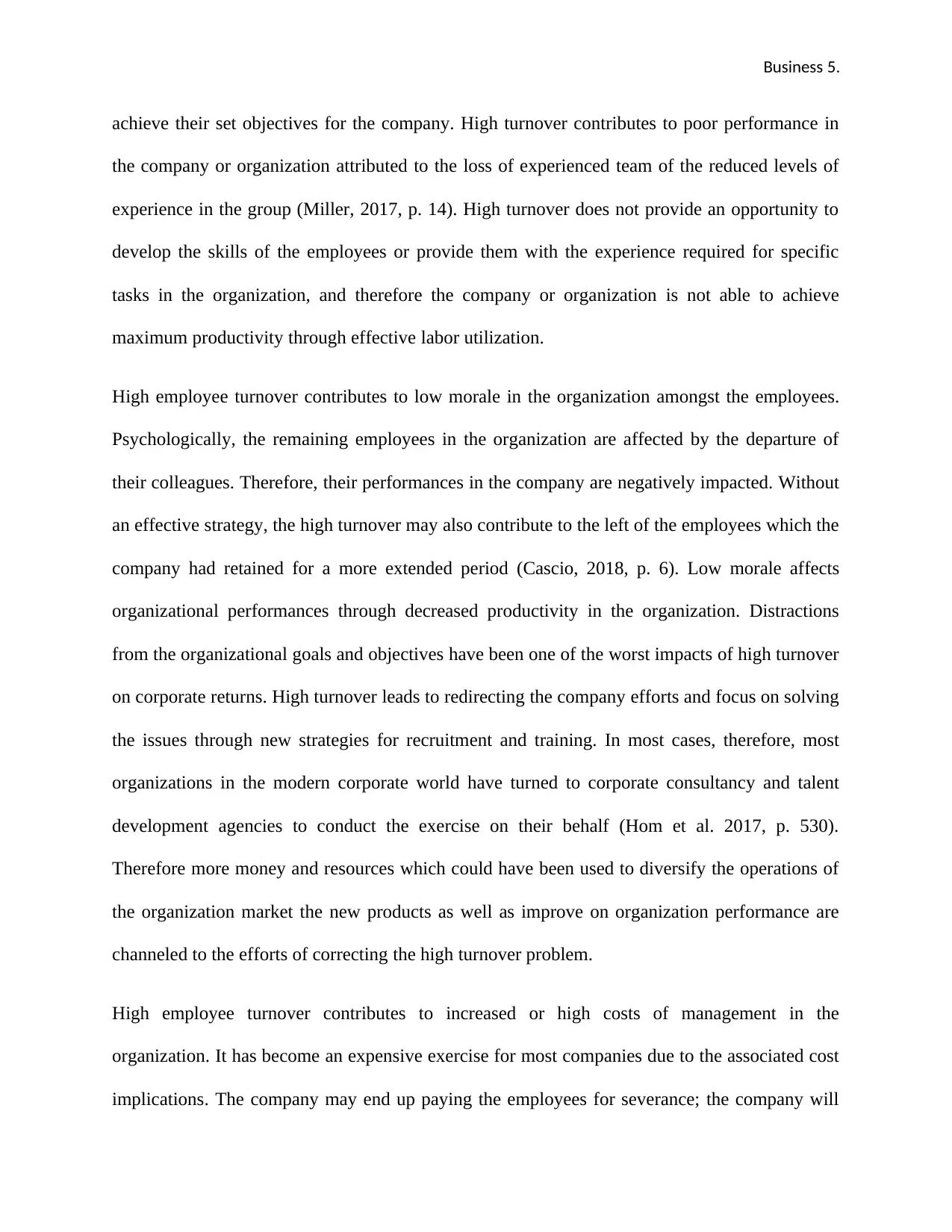
Business 5.
achieve their set objectives for the company. High turnover contributes to poor performance in
the company or organization attributed to the loss of experienced team of the reduced levels of
experience in the group (Miller, 2017, p. 14). High turnover does not provide an opportunity to
develop the skills of the employees or provide them with the experience required for specific
tasks in the organization, and therefore the company or organization is not able to achieve
maximum productivity through effective labor utilization.
High employee turnover contributes to low morale in the organization amongst the employees.
Psychologically, the remaining employees in the organization are affected by the departure of
their colleagues. Therefore, their performances in the company are negatively impacted. Without
an effective strategy, the high turnover may also contribute to the left of the employees which the
company had retained for a more extended period (Cascio, 2018, p. 6). Low morale affects
organizational performances through decreased productivity in the organization. Distractions
from the organizational goals and objectives have been one of the worst impacts of high turnover
on corporate returns. High turnover leads to redirecting the company efforts and focus on solving
the issues through new strategies for recruitment and training. In most cases, therefore, most
organizations in the modern corporate world have turned to corporate consultancy and talent
development agencies to conduct the exercise on their behalf (Hom et al. 2017, p. 530).
Therefore more money and resources which could have been used to diversify the operations of
the organization market the new products as well as improve on organization performance are
channeled to the efforts of correcting the high turnover problem.
High employee turnover contributes to increased or high costs of management in the
organization. It has become an expensive exercise for most companies due to the associated cost
implications. The company may end up paying the employees for severance; the company will
achieve their set objectives for the company. High turnover contributes to poor performance in
the company or organization attributed to the loss of experienced team of the reduced levels of
experience in the group (Miller, 2017, p. 14). High turnover does not provide an opportunity to
develop the skills of the employees or provide them with the experience required for specific
tasks in the organization, and therefore the company or organization is not able to achieve
maximum productivity through effective labor utilization.
High employee turnover contributes to low morale in the organization amongst the employees.
Psychologically, the remaining employees in the organization are affected by the departure of
their colleagues. Therefore, their performances in the company are negatively impacted. Without
an effective strategy, the high turnover may also contribute to the left of the employees which the
company had retained for a more extended period (Cascio, 2018, p. 6). Low morale affects
organizational performances through decreased productivity in the organization. Distractions
from the organizational goals and objectives have been one of the worst impacts of high turnover
on corporate returns. High turnover leads to redirecting the company efforts and focus on solving
the issues through new strategies for recruitment and training. In most cases, therefore, most
organizations in the modern corporate world have turned to corporate consultancy and talent
development agencies to conduct the exercise on their behalf (Hom et al. 2017, p. 530).
Therefore more money and resources which could have been used to diversify the operations of
the organization market the new products as well as improve on organization performance are
channeled to the efforts of correcting the high turnover problem.
High employee turnover contributes to increased or high costs of management in the
organization. It has become an expensive exercise for most companies due to the associated cost
implications. The company may end up paying the employees for severance; the company will
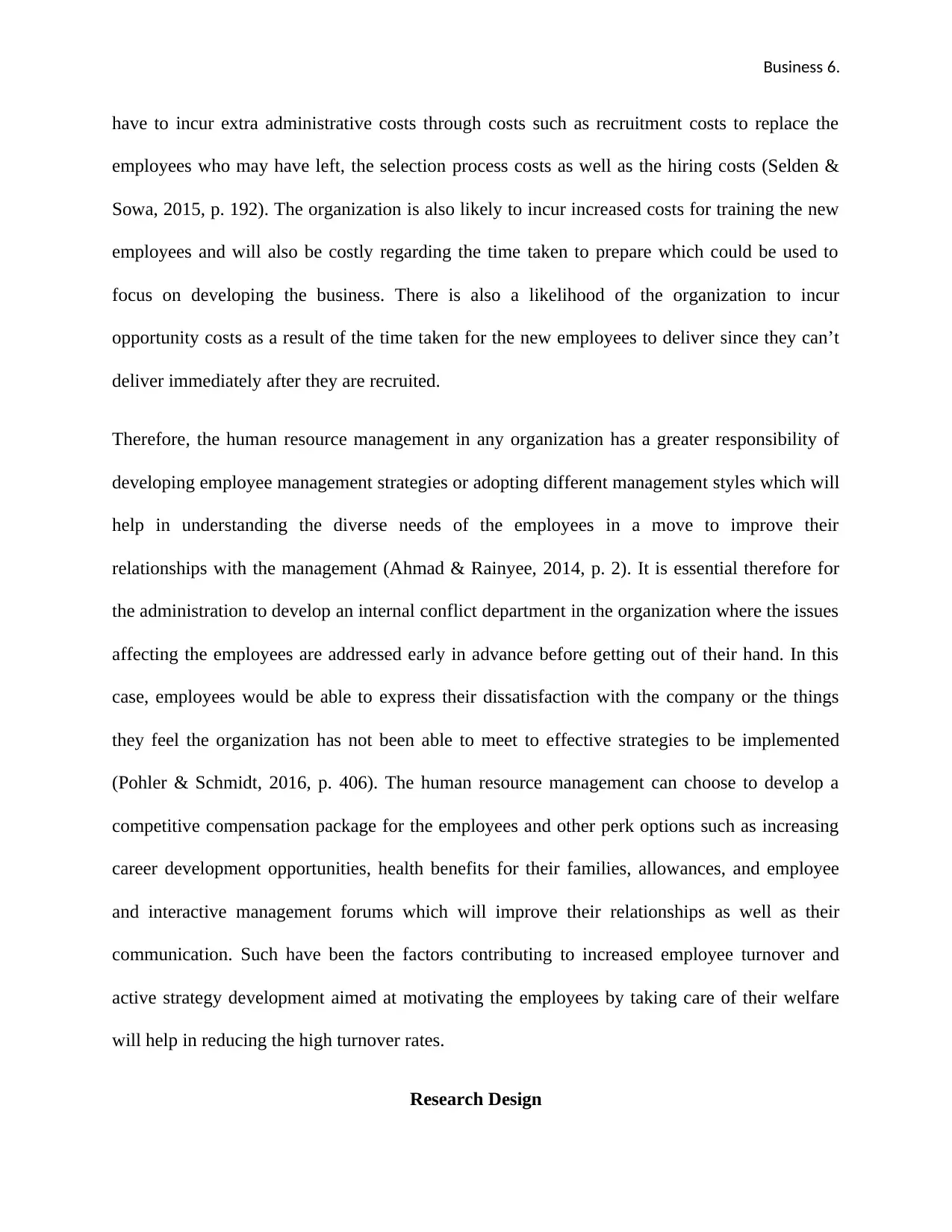
Business 6.
have to incur extra administrative costs through costs such as recruitment costs to replace the
employees who may have left, the selection process costs as well as the hiring costs (Selden &
Sowa, 2015, p. 192). The organization is also likely to incur increased costs for training the new
employees and will also be costly regarding the time taken to prepare which could be used to
focus on developing the business. There is also a likelihood of the organization to incur
opportunity costs as a result of the time taken for the new employees to deliver since they can’t
deliver immediately after they are recruited.
Therefore, the human resource management in any organization has a greater responsibility of
developing employee management strategies or adopting different management styles which will
help in understanding the diverse needs of the employees in a move to improve their
relationships with the management (Ahmad & Rainyee, 2014, p. 2). It is essential therefore for
the administration to develop an internal conflict department in the organization where the issues
affecting the employees are addressed early in advance before getting out of their hand. In this
case, employees would be able to express their dissatisfaction with the company or the things
they feel the organization has not been able to meet to effective strategies to be implemented
(Pohler & Schmidt, 2016, p. 406). The human resource management can choose to develop a
competitive compensation package for the employees and other perk options such as increasing
career development opportunities, health benefits for their families, allowances, and employee
and interactive management forums which will improve their relationships as well as their
communication. Such have been the factors contributing to increased employee turnover and
active strategy development aimed at motivating the employees by taking care of their welfare
will help in reducing the high turnover rates.
Research Design
have to incur extra administrative costs through costs such as recruitment costs to replace the
employees who may have left, the selection process costs as well as the hiring costs (Selden &
Sowa, 2015, p. 192). The organization is also likely to incur increased costs for training the new
employees and will also be costly regarding the time taken to prepare which could be used to
focus on developing the business. There is also a likelihood of the organization to incur
opportunity costs as a result of the time taken for the new employees to deliver since they can’t
deliver immediately after they are recruited.
Therefore, the human resource management in any organization has a greater responsibility of
developing employee management strategies or adopting different management styles which will
help in understanding the diverse needs of the employees in a move to improve their
relationships with the management (Ahmad & Rainyee, 2014, p. 2). It is essential therefore for
the administration to develop an internal conflict department in the organization where the issues
affecting the employees are addressed early in advance before getting out of their hand. In this
case, employees would be able to express their dissatisfaction with the company or the things
they feel the organization has not been able to meet to effective strategies to be implemented
(Pohler & Schmidt, 2016, p. 406). The human resource management can choose to develop a
competitive compensation package for the employees and other perk options such as increasing
career development opportunities, health benefits for their families, allowances, and employee
and interactive management forums which will improve their relationships as well as their
communication. Such have been the factors contributing to increased employee turnover and
active strategy development aimed at motivating the employees by taking care of their welfare
will help in reducing the high turnover rates.
Research Design
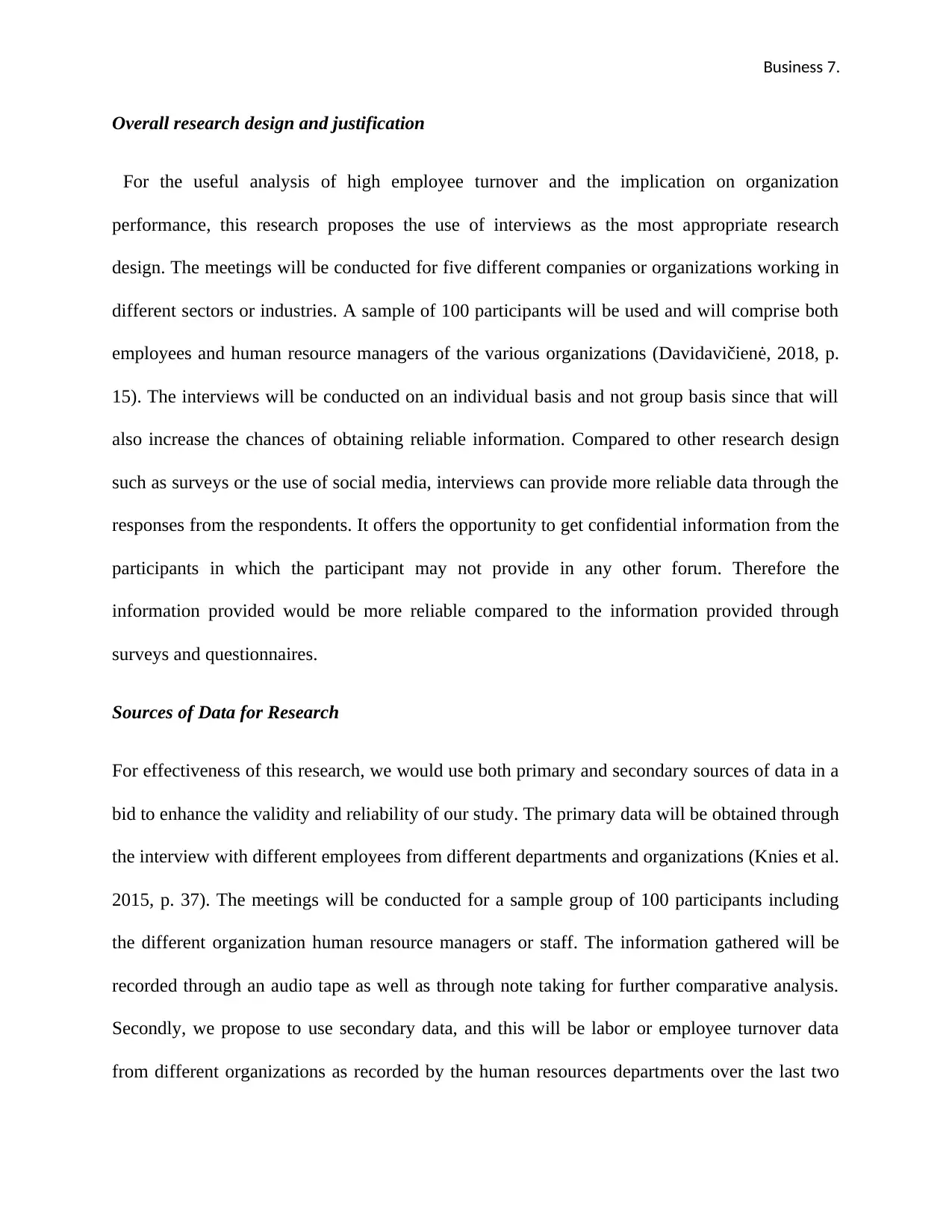
Business 7.
Overall research design and justification
For the useful analysis of high employee turnover and the implication on organization
performance, this research proposes the use of interviews as the most appropriate research
design. The meetings will be conducted for five different companies or organizations working in
different sectors or industries. A sample of 100 participants will be used and will comprise both
employees and human resource managers of the various organizations (Davidavičienė, 2018, p.
15). The interviews will be conducted on an individual basis and not group basis since that will
also increase the chances of obtaining reliable information. Compared to other research design
such as surveys or the use of social media, interviews can provide more reliable data through the
responses from the respondents. It offers the opportunity to get confidential information from the
participants in which the participant may not provide in any other forum. Therefore the
information provided would be more reliable compared to the information provided through
surveys and questionnaires.
Sources of Data for Research
For effectiveness of this research, we would use both primary and secondary sources of data in a
bid to enhance the validity and reliability of our study. The primary data will be obtained through
the interview with different employees from different departments and organizations (Knies et al.
2015, p. 37). The meetings will be conducted for a sample group of 100 participants including
the different organization human resource managers or staff. The information gathered will be
recorded through an audio tape as well as through note taking for further comparative analysis.
Secondly, we propose to use secondary data, and this will be labor or employee turnover data
from different organizations as recorded by the human resources departments over the last two
Overall research design and justification
For the useful analysis of high employee turnover and the implication on organization
performance, this research proposes the use of interviews as the most appropriate research
design. The meetings will be conducted for five different companies or organizations working in
different sectors or industries. A sample of 100 participants will be used and will comprise both
employees and human resource managers of the various organizations (Davidavičienė, 2018, p.
15). The interviews will be conducted on an individual basis and not group basis since that will
also increase the chances of obtaining reliable information. Compared to other research design
such as surveys or the use of social media, interviews can provide more reliable data through the
responses from the respondents. It offers the opportunity to get confidential information from the
participants in which the participant may not provide in any other forum. Therefore the
information provided would be more reliable compared to the information provided through
surveys and questionnaires.
Sources of Data for Research
For effectiveness of this research, we would use both primary and secondary sources of data in a
bid to enhance the validity and reliability of our study. The primary data will be obtained through
the interview with different employees from different departments and organizations (Knies et al.
2015, p. 37). The meetings will be conducted for a sample group of 100 participants including
the different organization human resource managers or staff. The information gathered will be
recorded through an audio tape as well as through note taking for further comparative analysis.
Secondly, we propose to use secondary data, and this will be labor or employee turnover data
from different organizations as recorded by the human resources departments over the last two
Paraphrase This Document
Need a fresh take? Get an instant paraphrase of this document with our AI Paraphraser
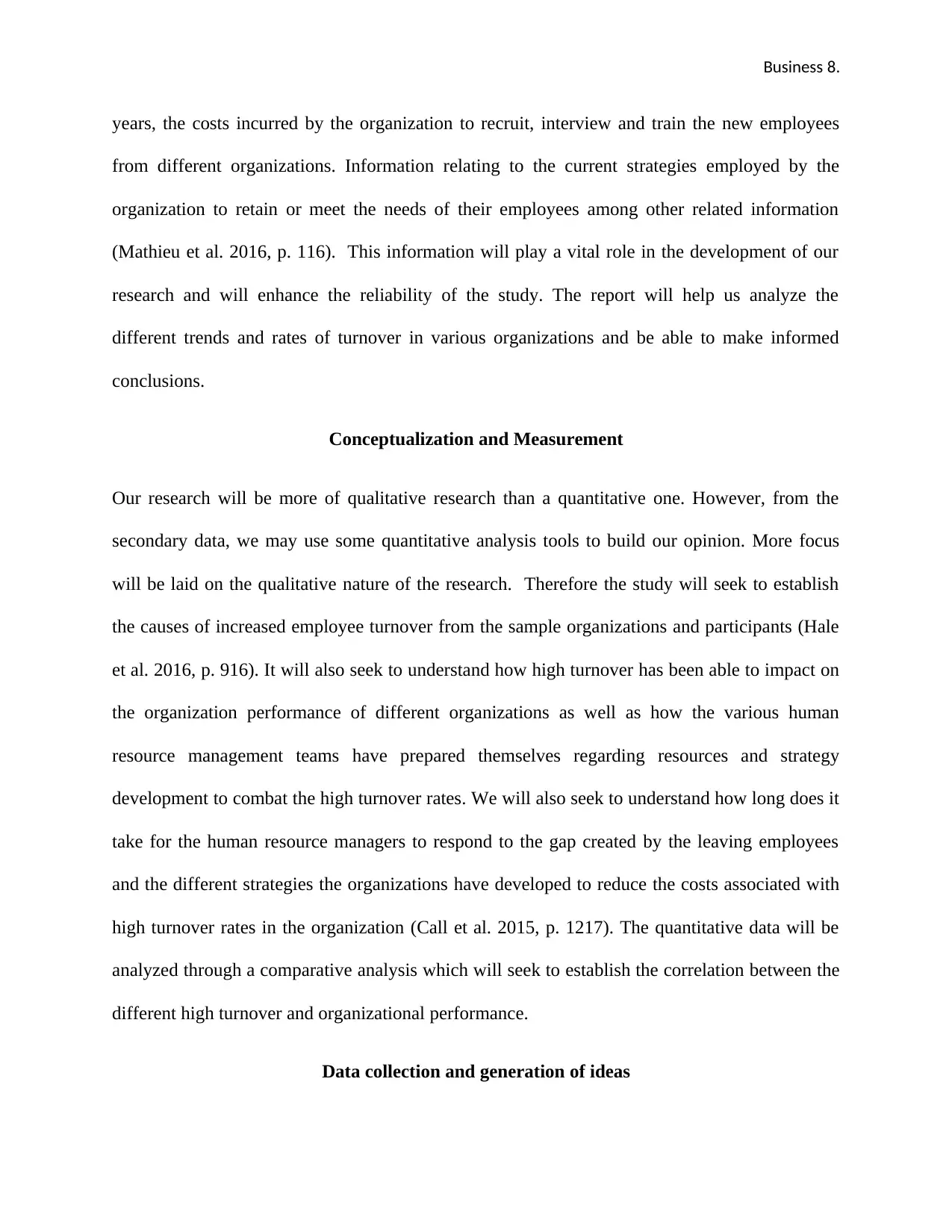
Business 8.
years, the costs incurred by the organization to recruit, interview and train the new employees
from different organizations. Information relating to the current strategies employed by the
organization to retain or meet the needs of their employees among other related information
(Mathieu et al. 2016, p. 116). This information will play a vital role in the development of our
research and will enhance the reliability of the study. The report will help us analyze the
different trends and rates of turnover in various organizations and be able to make informed
conclusions.
Conceptualization and Measurement
Our research will be more of qualitative research than a quantitative one. However, from the
secondary data, we may use some quantitative analysis tools to build our opinion. More focus
will be laid on the qualitative nature of the research. Therefore the study will seek to establish
the causes of increased employee turnover from the sample organizations and participants (Hale
et al. 2016, p. 916). It will also seek to understand how high turnover has been able to impact on
the organization performance of different organizations as well as how the various human
resource management teams have prepared themselves regarding resources and strategy
development to combat the high turnover rates. We will also seek to understand how long does it
take for the human resource managers to respond to the gap created by the leaving employees
and the different strategies the organizations have developed to reduce the costs associated with
high turnover rates in the organization (Call et al. 2015, p. 1217). The quantitative data will be
analyzed through a comparative analysis which will seek to establish the correlation between the
different high turnover and organizational performance.
Data collection and generation of ideas
years, the costs incurred by the organization to recruit, interview and train the new employees
from different organizations. Information relating to the current strategies employed by the
organization to retain or meet the needs of their employees among other related information
(Mathieu et al. 2016, p. 116). This information will play a vital role in the development of our
research and will enhance the reliability of the study. The report will help us analyze the
different trends and rates of turnover in various organizations and be able to make informed
conclusions.
Conceptualization and Measurement
Our research will be more of qualitative research than a quantitative one. However, from the
secondary data, we may use some quantitative analysis tools to build our opinion. More focus
will be laid on the qualitative nature of the research. Therefore the study will seek to establish
the causes of increased employee turnover from the sample organizations and participants (Hale
et al. 2016, p. 916). It will also seek to understand how high turnover has been able to impact on
the organization performance of different organizations as well as how the various human
resource management teams have prepared themselves regarding resources and strategy
development to combat the high turnover rates. We will also seek to understand how long does it
take for the human resource managers to respond to the gap created by the leaving employees
and the different strategies the organizations have developed to reduce the costs associated with
high turnover rates in the organization (Call et al. 2015, p. 1217). The quantitative data will be
analyzed through a comparative analysis which will seek to establish the correlation between the
different high turnover and organizational performance.
Data collection and generation of ideas
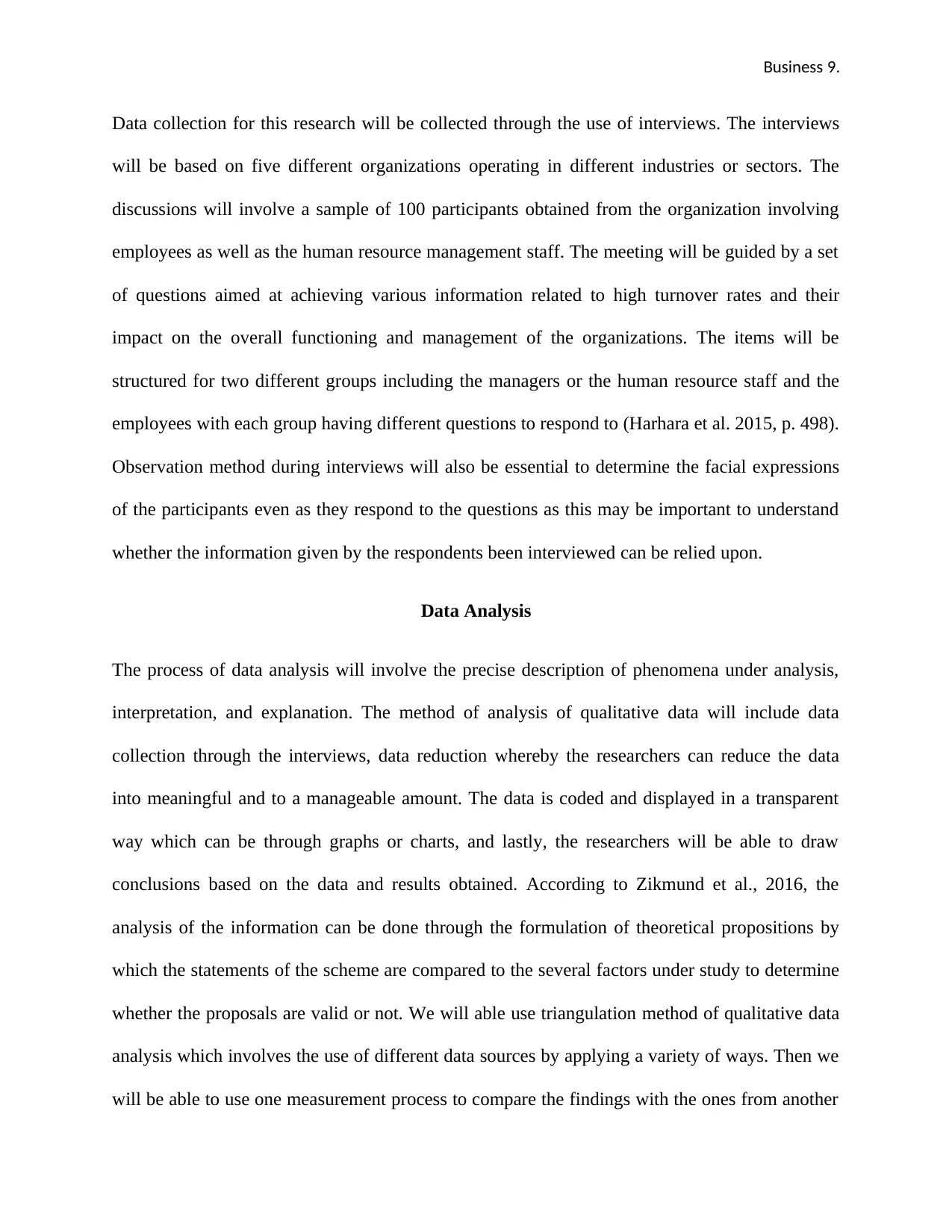
Business 9.
Data collection for this research will be collected through the use of interviews. The interviews
will be based on five different organizations operating in different industries or sectors. The
discussions will involve a sample of 100 participants obtained from the organization involving
employees as well as the human resource management staff. The meeting will be guided by a set
of questions aimed at achieving various information related to high turnover rates and their
impact on the overall functioning and management of the organizations. The items will be
structured for two different groups including the managers or the human resource staff and the
employees with each group having different questions to respond to (Harhara et al. 2015, p. 498).
Observation method during interviews will also be essential to determine the facial expressions
of the participants even as they respond to the questions as this may be important to understand
whether the information given by the respondents been interviewed can be relied upon.
Data Analysis
The process of data analysis will involve the precise description of phenomena under analysis,
interpretation, and explanation. The method of analysis of qualitative data will include data
collection through the interviews, data reduction whereby the researchers can reduce the data
into meaningful and to a manageable amount. The data is coded and displayed in a transparent
way which can be through graphs or charts, and lastly, the researchers will be able to draw
conclusions based on the data and results obtained. According to Zikmund et al., 2016, the
analysis of the information can be done through the formulation of theoretical propositions by
which the statements of the scheme are compared to the several factors under study to determine
whether the proposals are valid or not. We will able use triangulation method of qualitative data
analysis which involves the use of different data sources by applying a variety of ways. Then we
will be able to use one measurement process to compare the findings with the ones from another
Data collection for this research will be collected through the use of interviews. The interviews
will be based on five different organizations operating in different industries or sectors. The
discussions will involve a sample of 100 participants obtained from the organization involving
employees as well as the human resource management staff. The meeting will be guided by a set
of questions aimed at achieving various information related to high turnover rates and their
impact on the overall functioning and management of the organizations. The items will be
structured for two different groups including the managers or the human resource staff and the
employees with each group having different questions to respond to (Harhara et al. 2015, p. 498).
Observation method during interviews will also be essential to determine the facial expressions
of the participants even as they respond to the questions as this may be important to understand
whether the information given by the respondents been interviewed can be relied upon.
Data Analysis
The process of data analysis will involve the precise description of phenomena under analysis,
interpretation, and explanation. The method of analysis of qualitative data will include data
collection through the interviews, data reduction whereby the researchers can reduce the data
into meaningful and to a manageable amount. The data is coded and displayed in a transparent
way which can be through graphs or charts, and lastly, the researchers will be able to draw
conclusions based on the data and results obtained. According to Zikmund et al., 2016, the
analysis of the information can be done through the formulation of theoretical propositions by
which the statements of the scheme are compared to the several factors under study to determine
whether the proposals are valid or not. We will able use triangulation method of qualitative data
analysis which involves the use of different data sources by applying a variety of ways. Then we
will be able to use one measurement process to compare the findings with the ones from another
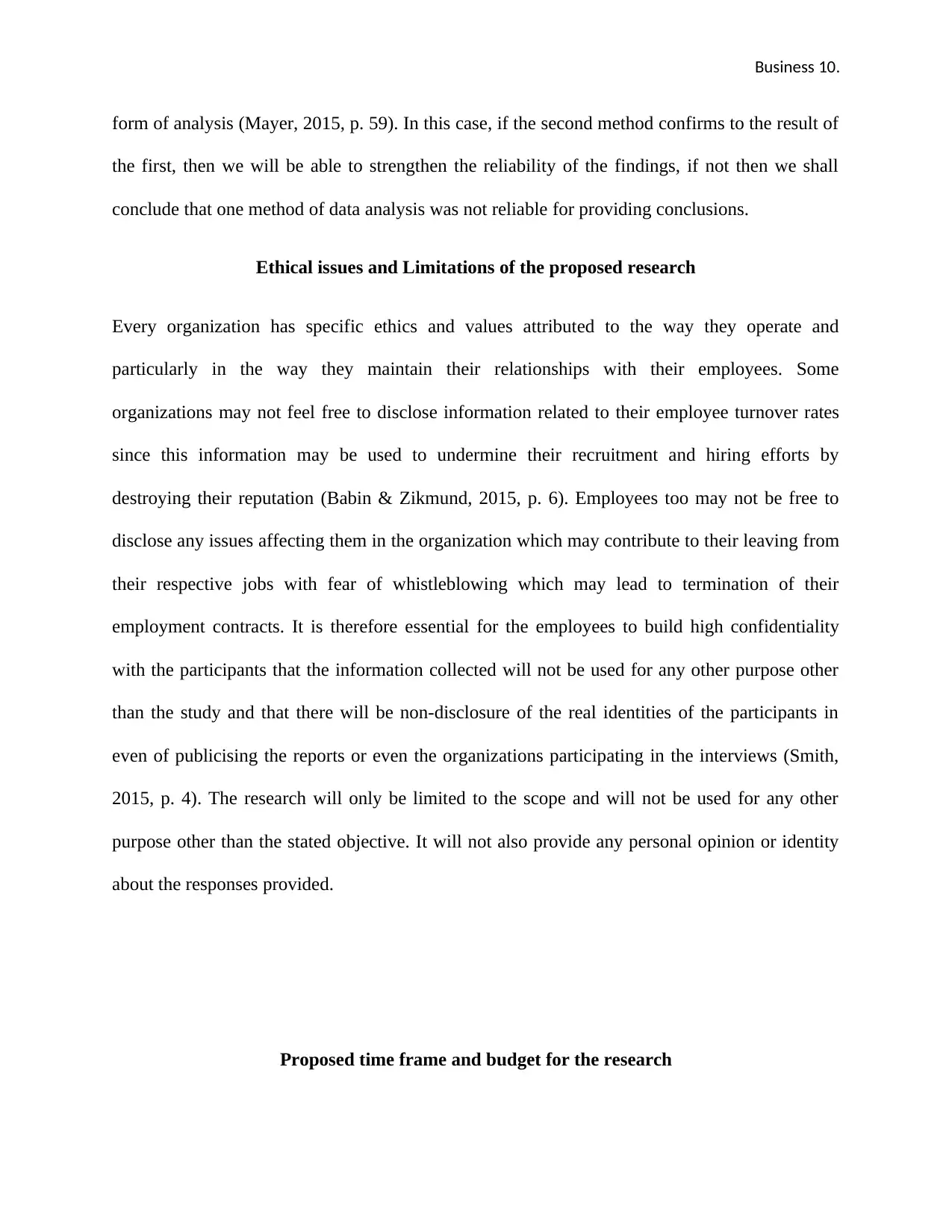
Business 10.
form of analysis (Mayer, 2015, p. 59). In this case, if the second method confirms to the result of
the first, then we will be able to strengthen the reliability of the findings, if not then we shall
conclude that one method of data analysis was not reliable for providing conclusions.
Ethical issues and Limitations of the proposed research
Every organization has specific ethics and values attributed to the way they operate and
particularly in the way they maintain their relationships with their employees. Some
organizations may not feel free to disclose information related to their employee turnover rates
since this information may be used to undermine their recruitment and hiring efforts by
destroying their reputation (Babin & Zikmund, 2015, p. 6). Employees too may not be free to
disclose any issues affecting them in the organization which may contribute to their leaving from
their respective jobs with fear of whistleblowing which may lead to termination of their
employment contracts. It is therefore essential for the employees to build high confidentiality
with the participants that the information collected will not be used for any other purpose other
than the study and that there will be non-disclosure of the real identities of the participants in
even of publicising the reports or even the organizations participating in the interviews (Smith,
2015, p. 4). The research will only be limited to the scope and will not be used for any other
purpose other than the stated objective. It will not also provide any personal opinion or identity
about the responses provided.
Proposed time frame and budget for the research
form of analysis (Mayer, 2015, p. 59). In this case, if the second method confirms to the result of
the first, then we will be able to strengthen the reliability of the findings, if not then we shall
conclude that one method of data analysis was not reliable for providing conclusions.
Ethical issues and Limitations of the proposed research
Every organization has specific ethics and values attributed to the way they operate and
particularly in the way they maintain their relationships with their employees. Some
organizations may not feel free to disclose information related to their employee turnover rates
since this information may be used to undermine their recruitment and hiring efforts by
destroying their reputation (Babin & Zikmund, 2015, p. 6). Employees too may not be free to
disclose any issues affecting them in the organization which may contribute to their leaving from
their respective jobs with fear of whistleblowing which may lead to termination of their
employment contracts. It is therefore essential for the employees to build high confidentiality
with the participants that the information collected will not be used for any other purpose other
than the study and that there will be non-disclosure of the real identities of the participants in
even of publicising the reports or even the organizations participating in the interviews (Smith,
2015, p. 4). The research will only be limited to the scope and will not be used for any other
purpose other than the stated objective. It will not also provide any personal opinion or identity
about the responses provided.
Proposed time frame and budget for the research
Secure Best Marks with AI Grader
Need help grading? Try our AI Grader for instant feedback on your assignments.
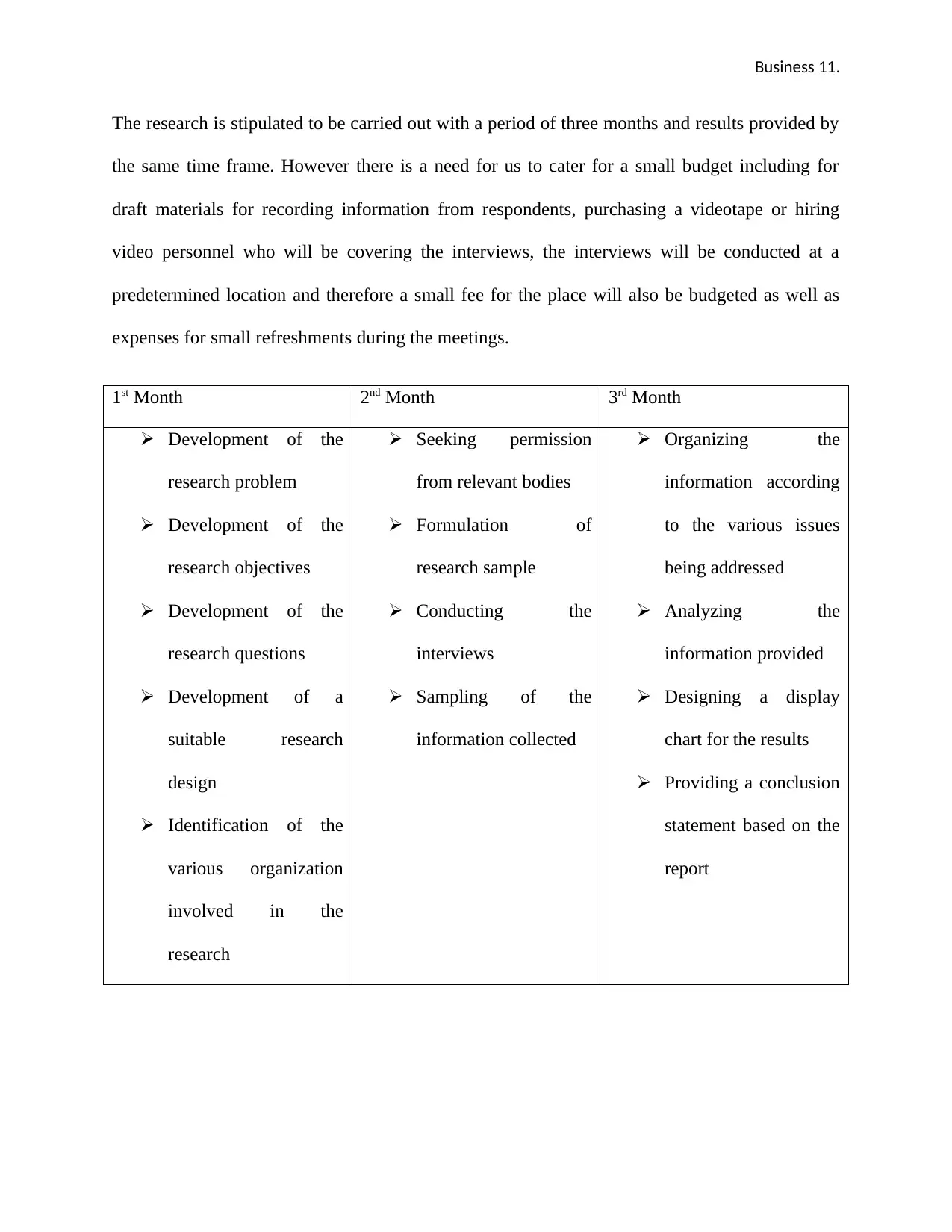
Business 11.
The research is stipulated to be carried out with a period of three months and results provided by
the same time frame. However there is a need for us to cater for a small budget including for
draft materials for recording information from respondents, purchasing a videotape or hiring
video personnel who will be covering the interviews, the interviews will be conducted at a
predetermined location and therefore a small fee for the place will also be budgeted as well as
expenses for small refreshments during the meetings.
1st Month 2nd Month 3rd Month
Development of the
research problem
Development of the
research objectives
Development of the
research questions
Development of a
suitable research
design
Identification of the
various organization
involved in the
research
Seeking permission
from relevant bodies
Formulation of
research sample
Conducting the
interviews
Sampling of the
information collected
Organizing the
information according
to the various issues
being addressed
Analyzing the
information provided
Designing a display
chart for the results
Providing a conclusion
statement based on the
report
The research is stipulated to be carried out with a period of three months and results provided by
the same time frame. However there is a need for us to cater for a small budget including for
draft materials for recording information from respondents, purchasing a videotape or hiring
video personnel who will be covering the interviews, the interviews will be conducted at a
predetermined location and therefore a small fee for the place will also be budgeted as well as
expenses for small refreshments during the meetings.
1st Month 2nd Month 3rd Month
Development of the
research problem
Development of the
research objectives
Development of the
research questions
Development of a
suitable research
design
Identification of the
various organization
involved in the
research
Seeking permission
from relevant bodies
Formulation of
research sample
Conducting the
interviews
Sampling of the
information collected
Organizing the
information according
to the various issues
being addressed
Analyzing the
information provided
Designing a display
chart for the results
Providing a conclusion
statement based on the
report
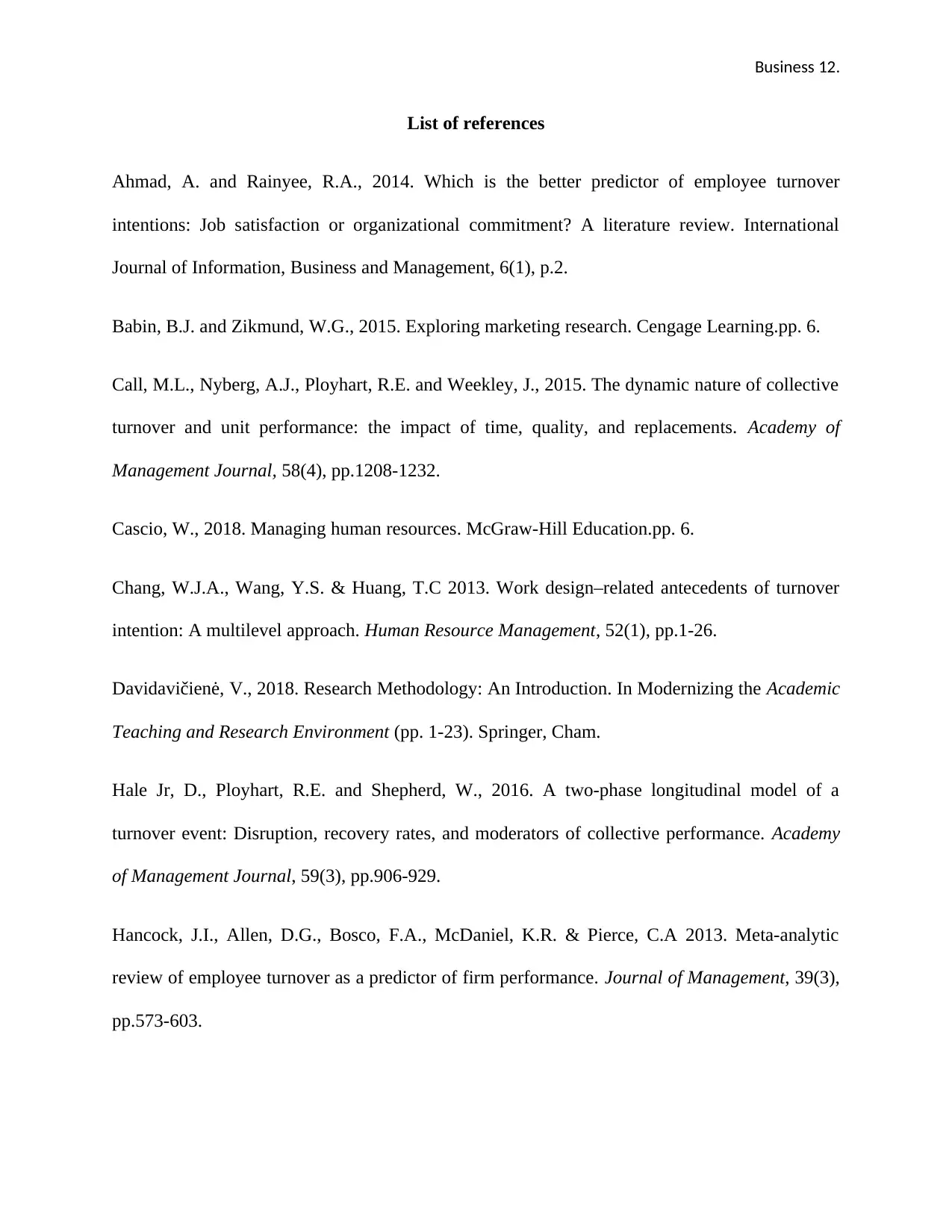
Business 12.
List of references
Ahmad, A. and Rainyee, R.A., 2014. Which is the better predictor of employee turnover
intentions: Job satisfaction or organizational commitment? A literature review. International
Journal of Information, Business and Management, 6(1), p.2.
Babin, B.J. and Zikmund, W.G., 2015. Exploring marketing research. Cengage Learning.pp. 6.
Call, M.L., Nyberg, A.J., Ployhart, R.E. and Weekley, J., 2015. The dynamic nature of collective
turnover and unit performance: the impact of time, quality, and replacements. Academy of
Management Journal, 58(4), pp.1208-1232.
Cascio, W., 2018. Managing human resources. McGraw-Hill Education.pp. 6.
Chang, W.J.A., Wang, Y.S. & Huang, T.C 2013. Work design–related antecedents of turnover
intention: A multilevel approach. Human Resource Management, 52(1), pp.1-26.
Davidavičienė, V., 2018. Research Methodology: An Introduction. In Modernizing the Academic
Teaching and Research Environment (pp. 1-23). Springer, Cham.
Hale Jr, D., Ployhart, R.E. and Shepherd, W., 2016. A two-phase longitudinal model of a
turnover event: Disruption, recovery rates, and moderators of collective performance. Academy
of Management Journal, 59(3), pp.906-929.
Hancock, J.I., Allen, D.G., Bosco, F.A., McDaniel, K.R. & Pierce, C.A 2013. Meta-analytic
review of employee turnover as a predictor of firm performance. Journal of Management, 39(3),
pp.573-603.
List of references
Ahmad, A. and Rainyee, R.A., 2014. Which is the better predictor of employee turnover
intentions: Job satisfaction or organizational commitment? A literature review. International
Journal of Information, Business and Management, 6(1), p.2.
Babin, B.J. and Zikmund, W.G., 2015. Exploring marketing research. Cengage Learning.pp. 6.
Call, M.L., Nyberg, A.J., Ployhart, R.E. and Weekley, J., 2015. The dynamic nature of collective
turnover and unit performance: the impact of time, quality, and replacements. Academy of
Management Journal, 58(4), pp.1208-1232.
Cascio, W., 2018. Managing human resources. McGraw-Hill Education.pp. 6.
Chang, W.J.A., Wang, Y.S. & Huang, T.C 2013. Work design–related antecedents of turnover
intention: A multilevel approach. Human Resource Management, 52(1), pp.1-26.
Davidavičienė, V., 2018. Research Methodology: An Introduction. In Modernizing the Academic
Teaching and Research Environment (pp. 1-23). Springer, Cham.
Hale Jr, D., Ployhart, R.E. and Shepherd, W., 2016. A two-phase longitudinal model of a
turnover event: Disruption, recovery rates, and moderators of collective performance. Academy
of Management Journal, 59(3), pp.906-929.
Hancock, J.I., Allen, D.G., Bosco, F.A., McDaniel, K.R. & Pierce, C.A 2013. Meta-analytic
review of employee turnover as a predictor of firm performance. Journal of Management, 39(3),
pp.573-603.
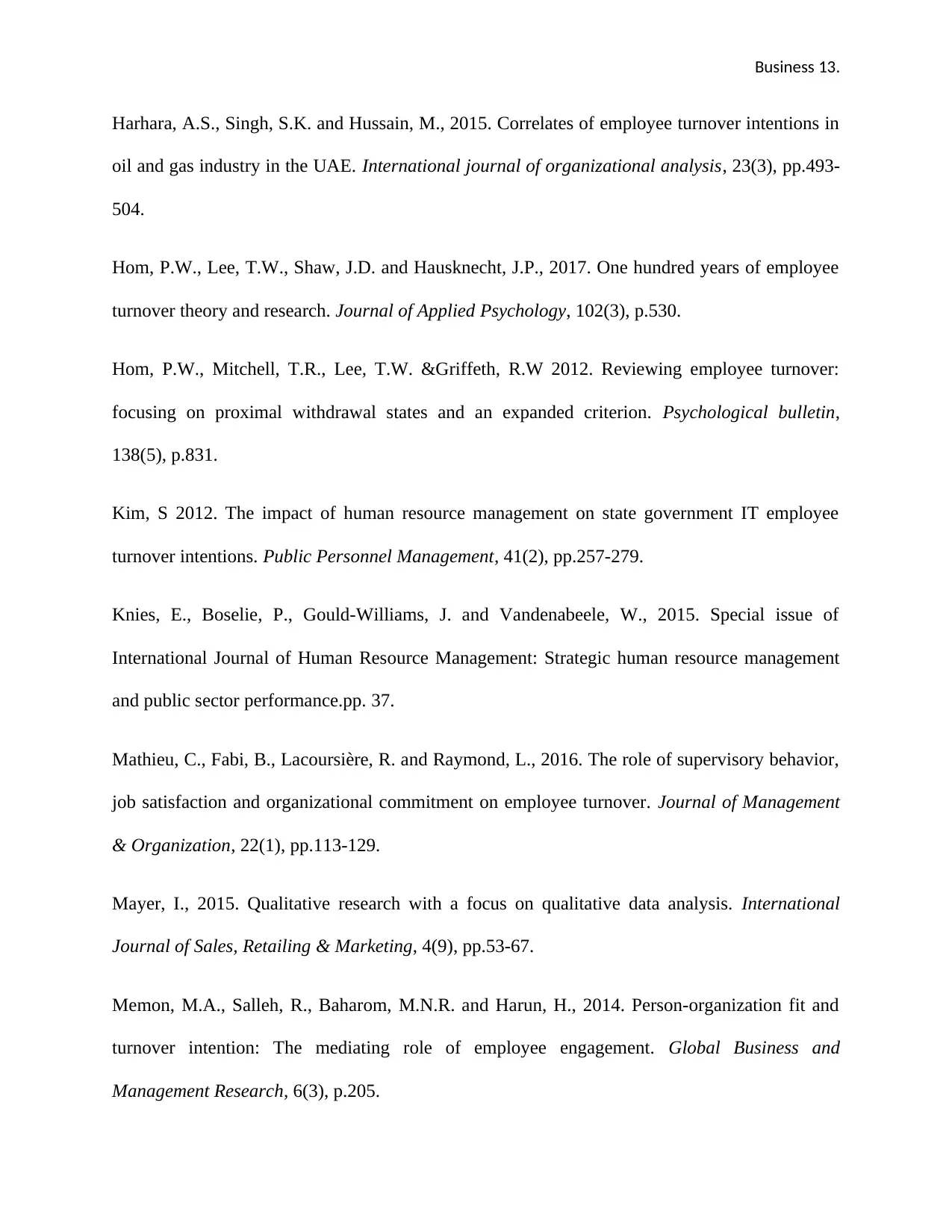
Business 13.
Harhara, A.S., Singh, S.K. and Hussain, M., 2015. Correlates of employee turnover intentions in
oil and gas industry in the UAE. International journal of organizational analysis, 23(3), pp.493-
504.
Hom, P.W., Lee, T.W., Shaw, J.D. and Hausknecht, J.P., 2017. One hundred years of employee
turnover theory and research. Journal of Applied Psychology, 102(3), p.530.
Hom, P.W., Mitchell, T.R., Lee, T.W. &Griffeth, R.W 2012. Reviewing employee turnover:
focusing on proximal withdrawal states and an expanded criterion. Psychological bulletin,
138(5), p.831.
Kim, S 2012. The impact of human resource management on state government IT employee
turnover intentions. Public Personnel Management, 41(2), pp.257-279.
Knies, E., Boselie, P., Gould-Williams, J. and Vandenabeele, W., 2015. Special issue of
International Journal of Human Resource Management: Strategic human resource management
and public sector performance.pp. 37.
Mathieu, C., Fabi, B., Lacoursière, R. and Raymond, L., 2016. The role of supervisory behavior,
job satisfaction and organizational commitment on employee turnover. Journal of Management
& Organization, 22(1), pp.113-129.
Mayer, I., 2015. Qualitative research with a focus on qualitative data analysis. International
Journal of Sales, Retailing & Marketing, 4(9), pp.53-67.
Memon, M.A., Salleh, R., Baharom, M.N.R. and Harun, H., 2014. Person-organization fit and
turnover intention: The mediating role of employee engagement. Global Business and
Management Research, 6(3), p.205.
Harhara, A.S., Singh, S.K. and Hussain, M., 2015. Correlates of employee turnover intentions in
oil and gas industry in the UAE. International journal of organizational analysis, 23(3), pp.493-
504.
Hom, P.W., Lee, T.W., Shaw, J.D. and Hausknecht, J.P., 2017. One hundred years of employee
turnover theory and research. Journal of Applied Psychology, 102(3), p.530.
Hom, P.W., Mitchell, T.R., Lee, T.W. &Griffeth, R.W 2012. Reviewing employee turnover:
focusing on proximal withdrawal states and an expanded criterion. Psychological bulletin,
138(5), p.831.
Kim, S 2012. The impact of human resource management on state government IT employee
turnover intentions. Public Personnel Management, 41(2), pp.257-279.
Knies, E., Boselie, P., Gould-Williams, J. and Vandenabeele, W., 2015. Special issue of
International Journal of Human Resource Management: Strategic human resource management
and public sector performance.pp. 37.
Mathieu, C., Fabi, B., Lacoursière, R. and Raymond, L., 2016. The role of supervisory behavior,
job satisfaction and organizational commitment on employee turnover. Journal of Management
& Organization, 22(1), pp.113-129.
Mayer, I., 2015. Qualitative research with a focus on qualitative data analysis. International
Journal of Sales, Retailing & Marketing, 4(9), pp.53-67.
Memon, M.A., Salleh, R., Baharom, M.N.R. and Harun, H., 2014. Person-organization fit and
turnover intention: The mediating role of employee engagement. Global Business and
Management Research, 6(3), p.205.
Paraphrase This Document
Need a fresh take? Get an instant paraphrase of this document with our AI Paraphraser
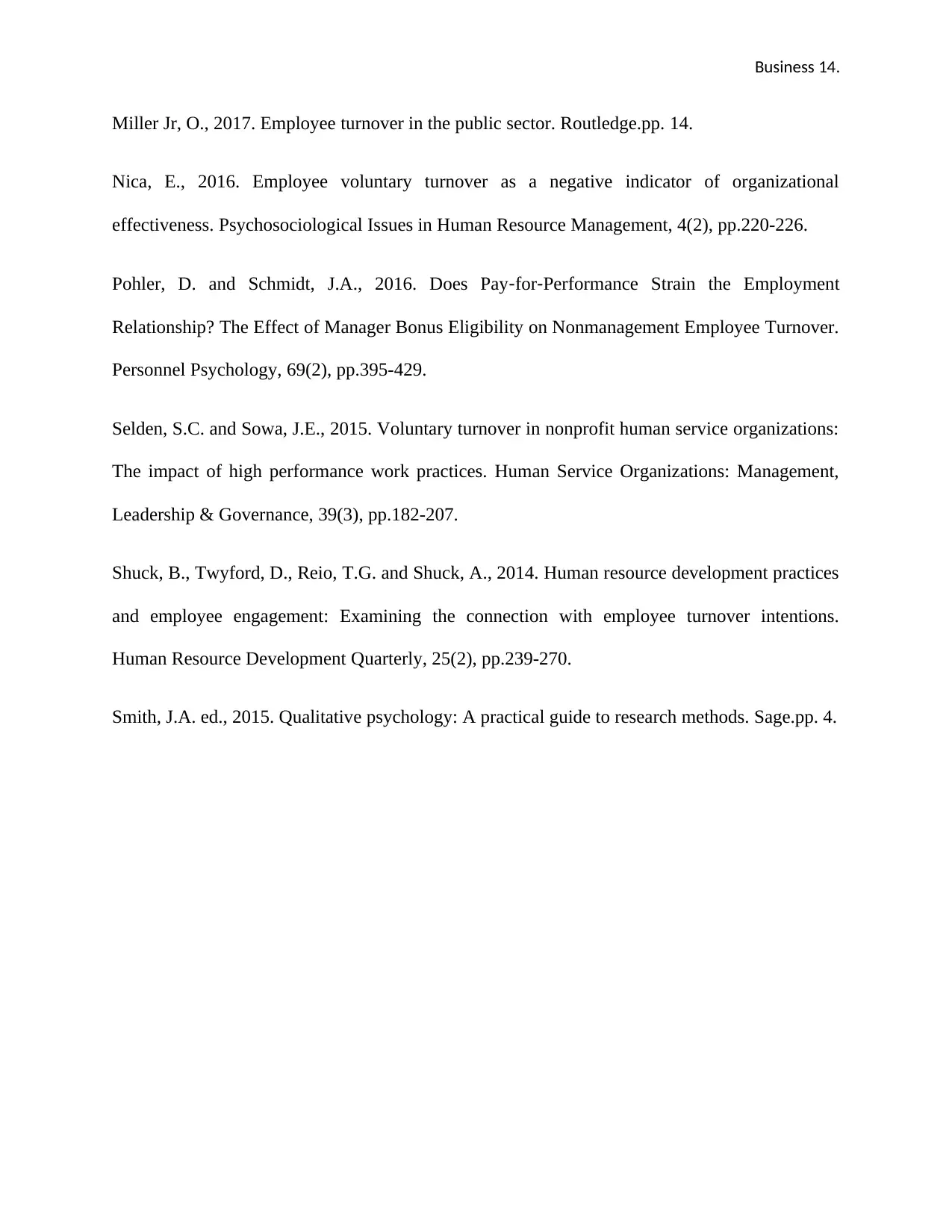
Business 14.
Miller Jr, O., 2017. Employee turnover in the public sector. Routledge.pp. 14.
Nica, E., 2016. Employee voluntary turnover as a negative indicator of organizational
effectiveness. Psychosociological Issues in Human Resource Management, 4(2), pp.220-226.
Pohler, D. and Schmidt, J.A., 2016. Does Pay‐for‐Performance Strain the Employment
Relationship? The Effect of Manager Bonus Eligibility on Nonmanagement Employee Turnover.
Personnel Psychology, 69(2), pp.395-429.
Selden, S.C. and Sowa, J.E., 2015. Voluntary turnover in nonprofit human service organizations:
The impact of high performance work practices. Human Service Organizations: Management,
Leadership & Governance, 39(3), pp.182-207.
Shuck, B., Twyford, D., Reio, T.G. and Shuck, A., 2014. Human resource development practices
and employee engagement: Examining the connection with employee turnover intentions.
Human Resource Development Quarterly, 25(2), pp.239-270.
Smith, J.A. ed., 2015. Qualitative psychology: A practical guide to research methods. Sage.pp. 4.
Miller Jr, O., 2017. Employee turnover in the public sector. Routledge.pp. 14.
Nica, E., 2016. Employee voluntary turnover as a negative indicator of organizational
effectiveness. Psychosociological Issues in Human Resource Management, 4(2), pp.220-226.
Pohler, D. and Schmidt, J.A., 2016. Does Pay‐for‐Performance Strain the Employment
Relationship? The Effect of Manager Bonus Eligibility on Nonmanagement Employee Turnover.
Personnel Psychology, 69(2), pp.395-429.
Selden, S.C. and Sowa, J.E., 2015. Voluntary turnover in nonprofit human service organizations:
The impact of high performance work practices. Human Service Organizations: Management,
Leadership & Governance, 39(3), pp.182-207.
Shuck, B., Twyford, D., Reio, T.G. and Shuck, A., 2014. Human resource development practices
and employee engagement: Examining the connection with employee turnover intentions.
Human Resource Development Quarterly, 25(2), pp.239-270.
Smith, J.A. ed., 2015. Qualitative psychology: A practical guide to research methods. Sage.pp. 4.
1 out of 14
Your All-in-One AI-Powered Toolkit for Academic Success.
+13062052269
info@desklib.com
Available 24*7 on WhatsApp / Email
![[object Object]](/_next/static/media/star-bottom.7253800d.svg)
Unlock your academic potential
© 2024 | Zucol Services PVT LTD | All rights reserved.


